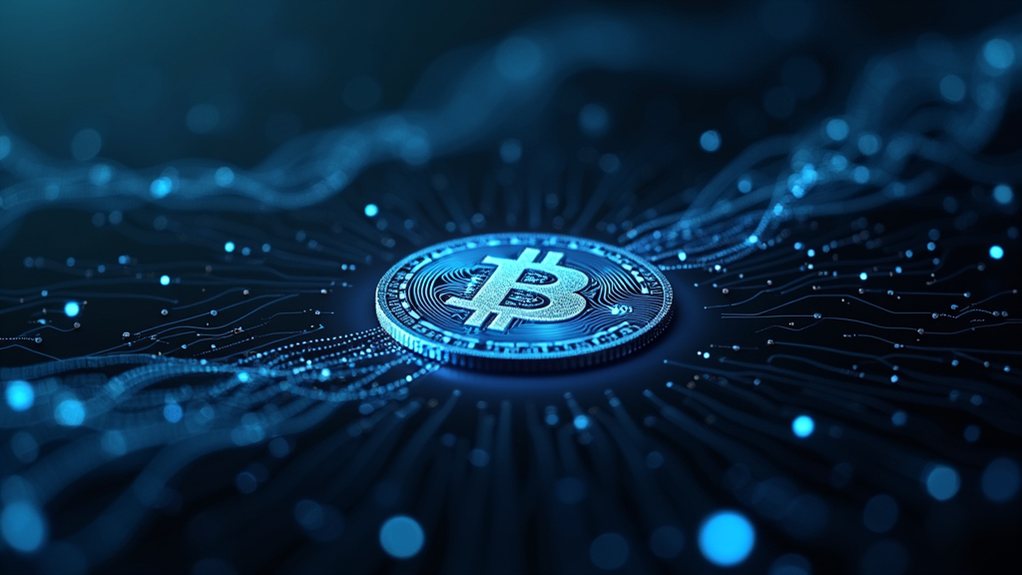Bitcoins aren't physical objects but are made of computer code and data. They exist digitally as entries on a blockchain, which is a distributed ledger stored across thousands of computers worldwide. Each bitcoin is secured through complex cryptography that prevents counterfeiting and double-spending. Miners create new bitcoins by solving difficult mathematical problems that verify transactions. Behind the digital currency lies an intricate system of mathematics, programming, and consensus.

While many people think of money as physical coins and paper bills, Bitcoin exists entirely in the digital world. It's a type of money that you can't touch or hold. Bitcoin is made up of lines of computer code that exist only as data on networks of computers around the world. Unlike traditional money printed on paper or stamped in metal, Bitcoin is created through complex mathematical calculations that happen on computers.
Bitcoin's foundation is built on cryptography, which is a fancy word for secret codes that keep information secure. The system uses something called SHA-256, a special math formula that turns information into a unique string of letters and numbers. This helps verify who owns which bitcoins and prevents people from copying or spending the same bitcoin twice. Digital signatures, similar to signing a check but done with computer code, prove that you're the rightful owner of your bitcoins.
Cryptography is Bitcoin's security guard, using math and digital signatures to protect ownership and prevent counterfeiting.
The heart of Bitcoin is blockchain technology. This is like a giant digital ledger that records every single Bitcoin transaction ever made. The blockchain is stored on thousands of computers worldwide, with each computer having an identical copy. When someone sends Bitcoin to another person, this transaction gets grouped with others into a "block." Once verified, this block gets added to the chain of previous blocks, creating a permanent record that can't be changed or deleted. The first block, known as the genesis block, was mined on January 3, 2009, and contained a message about a bank bailout. This decentralized ledger creates a trustless system where transactions can occur without requiring faith in any central authority or intermediary.
New bitcoins come into existence through a process called mining. Miners are people who use powerful computers to solve difficult math problems. When they solve these problems, they help verify transactions and add them to the blockchain. As a reward, they receive newly created bitcoins. The difficulty of these math problems adjusts automatically every 2016 blocks to guarantee new bitcoins are created at a steady rate. These miners also create what's called a Merkle tree, which efficiently organizes transaction data to ensure it remains tamper-proof.
What makes Bitcoin special is that it doesn't rely on any central authority like a bank or government. Instead, it operates on a network where all participants are equal. This network reaches agreement about which transactions are valid through rules built into the software. Anyone can download the Bitcoin software and help maintain the network by running what's called a "node."
Bitcoin's software is open source, meaning anyone can look at the code that makes it work. Programmers from around the world volunteer their time to improve it, with changes decided by community agreement. There will only ever be 21 million bitcoins, with over 19 million already created. The last bitcoin is expected to be mined around the year 2140, making it a limited resource unlike traditional money that can be printed endlessly.
Frequently Asked Questions
How Do Bitcoin Transactions Appear on the Blockchain?
Bitcoin transactions appear publicly on the blockchain for anyone to view. Each transaction shows who sent bitcoins, who received them, and how much was transferred.
When someone sends bitcoin, the transaction first waits in the mempool. Miners then include it in a block. Once added, the transaction is confirmed.
Block explorers let users search and view these transactions easily.
Can Governments Regulate or Ban Bitcoin?
Governments can regulate Bitcoin exchanges and services, but controlling the cryptocurrency itself is challenging.
Countries like China have banned Bitcoin mining and trading, while others like Japan and the EU have created legal frameworks.
Bitcoin's decentralized nature makes complete bans difficult to enforce. Users often find ways around restrictions through VPNs or foreign exchanges.
Regulation varies widely across different nations.
What Happens to Lost Bitcoin Wallets?
Lost Bitcoin wallets are gone forever, with no way to recover the funds if passwords or private keys are forgotten.
About 3.7 million bitcoins (17% of all Bitcoin) are estimated to be permanently lost. These losses increase scarcity and may boost the value of remaining coins.
While some data recovery tools exist, success rates are low. The most famous case involves James Howells, who accidentally discarded a hard drive containing 7,500 bitcoins.
How Does Bitcoin Mining Affect the Environment?
Bitcoin mining has significant environmental impacts. It consumes more electricity than Argentina annually, representing about 0.5% of global electricity usage.
The process generates 65-85 megatons of CO2 yearly, comparable to Greece's emissions. Mining creates substantial e-waste and has large water and land footprints.
While sustainability efforts exist, with over 50% of mining using renewable energy, the industry's environmental footprint remains considerable.
Will Bitcoin Replace Traditional Currencies?
Bitcoin isn't likely to fully replace traditional currencies soon.
While adoption is growing with 18% of Americans now owning Bitcoin and countries like El Salvador accepting it as legal tender, challenges remain.
Price volatility, regulatory uncertainty, and limited scalability hinder its use as everyday money.
Experts predict Bitcoin will continue to coexist alongside traditional currencies rather than replace them entirely.
Integration with financial systems is expanding gradually.










